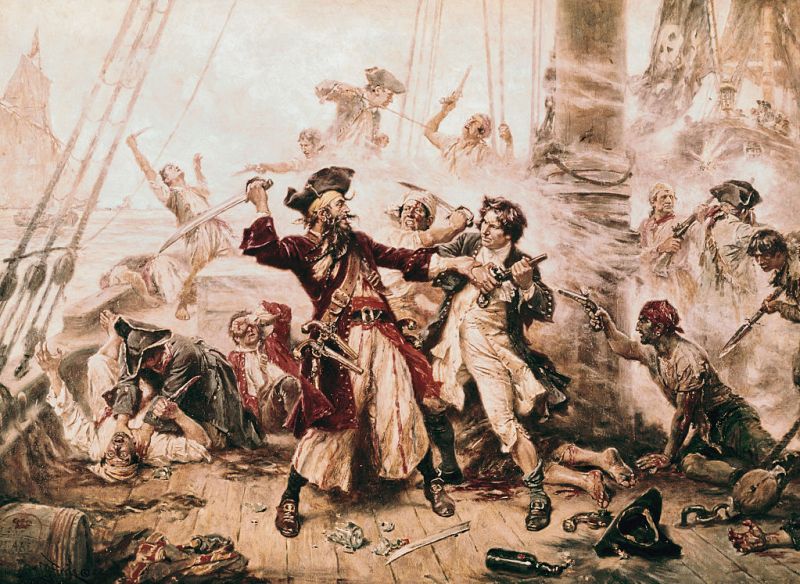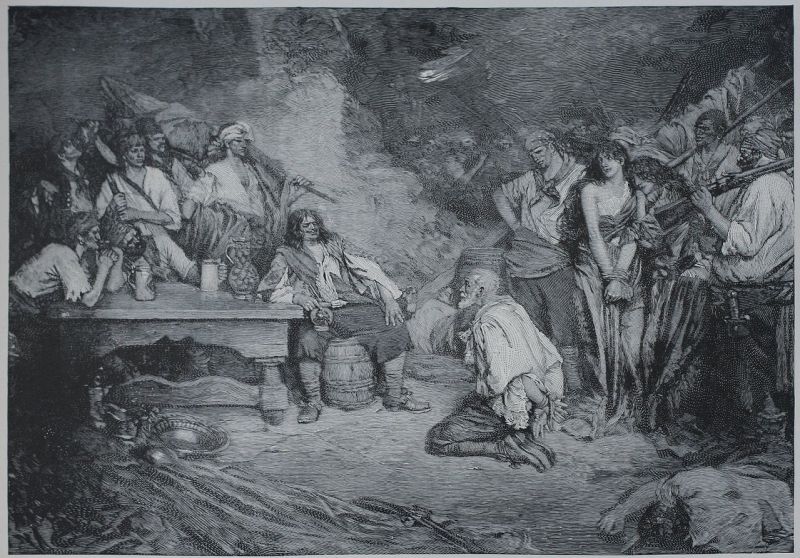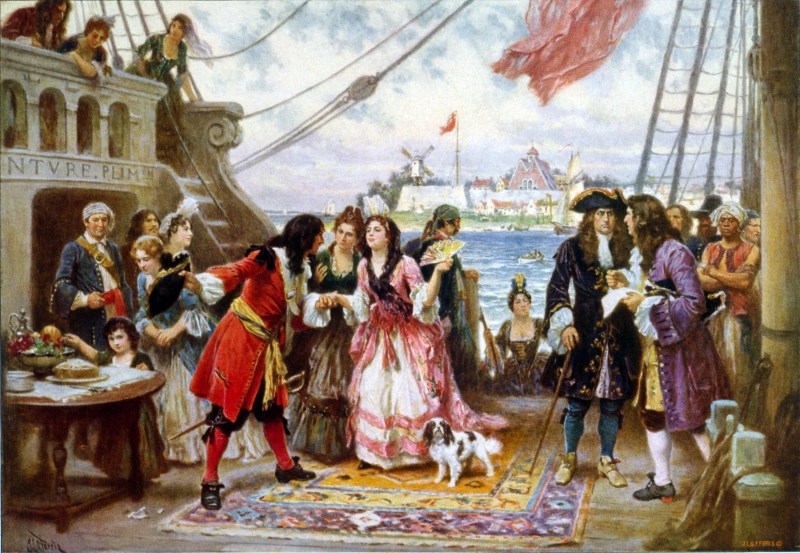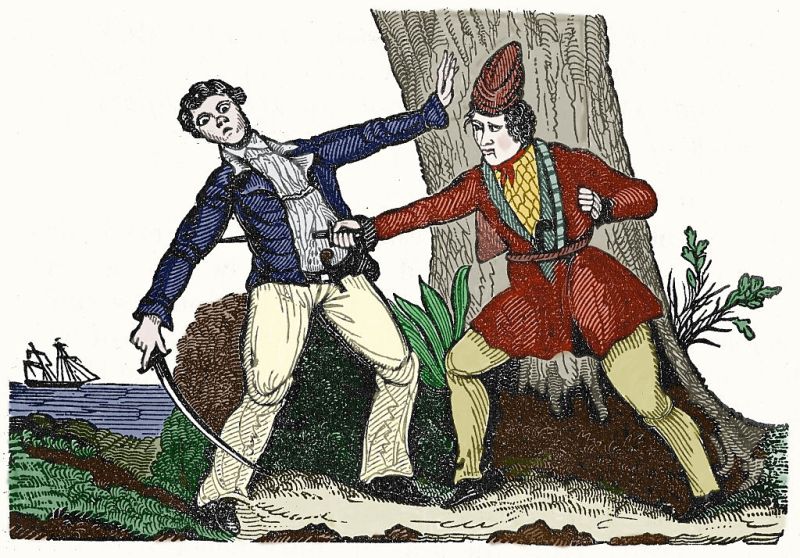For decades, pirates have been key figures in tales of danger, adventure and mayhem. Movies like Pirates of the Caribbean and Treasure Island make it hard to separate reality from fantasy. But the true life of an 18th-century pirate was pretty grim, and revolved around staggering violence and poverty, constant danger and most likely, death. The period of the late 1600s to the early 1700s is referred to as the “Golden Age of Piracy”—though pirates existed long before and after this time. The pirates of that era were mostly looking for silver and gold, but they mostly pillaged and stole goods like grain, molasses, and kegs of rum from merchant ships.
Though Captain Hook and Long John Silver did not exist, many other infamous pirates did, and they played a major role in shaping Western history. Likewise, much of pirate lore involves myths or tropes, such as buried treasure and walking the plank. But some stories hold true.
Pirates did often wear earrings, though not for fashion. Some believed putting pressure on their earlobes prevented seasickness, while others thought that metals possessed magical healing powers and that a gold earring was a protective talisman that would prevent someone from drowning when wearing it. Likewise, pirates routinely kept parrots as pets and participated in gruesome, often deadly, sword fights and sea battles.
Take a look at the gallery below to learn more about those who shaped our modern understanding of piracy.
Blackbeard

Blackbeard, or Captain Edward Teach or Thatch, was the worst and perhaps the cruelest pirate to ever sail the seas. He was born in Britain sometime before 1690. He started out on a British privateer, which were armed, mercenary ships hired by the British government to attack and plunder French and Spanish ships during wartime. He became captain of one of the ships he stole and started preying on ships traveling the American coast. Tales of his cruelty are legendary. His long black beard reportedly covered almost his full face, though he would sometimes tie them into separate tails.
Anne Bonny
Anne BonnyBonny’s story is remarkable for many reasons, but most notable was that she was able to become an equal crewmember and a respected pirate as a woman. She was the illegitimate child of lawyer William Cormac and his servant woman, Mary Brennan. Her mom died when Bonny was in her late teens, and she had to take care of her father’s household. She married a small-time pirate, but fell in love with John “Calico Jack” Rackham, and later joined his crew. She was known for her “fierce and courageous temper,” and one legend claims she nearly beat a man to death when he tried to force himself on her. Bonney and Rackham spent years capturing other ships before they were eventually captured.
John “Calico Jack” Rackham
A woodcut of John “Calico Jack” Packham from Charles Johnson’s 1725 edition of “A General History of the Pyrates.”“Calico Jack,” real name John Rackham, was not a great fighter, but he amassed incredible wealth and respect. On top of that, he had two female pirate crew members, including his wife, Anne Bonny. His greatest legacy comes from pioneering the use of the iconic Jolly Rogers flag, featuring a white human skull and two white crossed swords on a black background.
Bartholomew Roberts
Bartholomew Roberts with his ship and captured merchant ships in the background, on a copper engraving from “A History of the Pyrates” by Captain Charles Johnson, circa 1724.Born John Roberts, Bartholomew Roberts was probably the most successful pirate in terms of plundering ships. Rumor has it, he captured or looted around 400 ships during his career. He had a love for fine clothing and jewelry, and was not as cruel as some other pirates, and he was known to give gifts to cooperative captains and crews of captured ships. He is one of the four captains mentioned in Robert Louis Stevenson’s Treasure Island and much of popular culture surrounding pirates includes stories of him. He is likely the inspiration behind the character of Pirate Lord Bartholomew in the Pirates of the Caribbean series.
Captain Morgan

Yes, the guy on the rum bottles. He has a real-life counterpart named Sir Henry Morgan, who was a privateer, like Blackbeard, which means he wasn’t technically a pirate because his pillaging and robbing was sanctioned by the British government. He was hired by the government to protect British colonial interests in the Caribbean at any cost. He spent about two decades raiding Spanish ships and causing mayhem in cities. He was accused of widespread torture and other horrific offenses. After his death in 1688, his life was quickly romanticized.
Cheng I Sao
Cheng I SaoCheng I Sao was a Cantonese former prostitute who married a powerful man named Cheng I in 1801. The couple raised one of China’s most formidable pirate armies and, at their height, it is thought they controlled some 50,000 men. Their pirates mainly preyed on fishing vessels, supply ships and the coastal villages around Southern China. When her husband died, Cheng took control and plundered her away across Southeast Asia. She also penned a rigorous code of conduct among her pirates. She retired as one of the world’s most successful pirates and she ran a gambling house until she died at 69-years-old.
Captain Kidd

William Kidd was born in Scotland in 1645 and started out as a privateer. He was captured and tried by the British government and hung in London in 1701 as a warning to other pirates. He is one of history’s most famous pirates because he attacked and took over the Quedagh Merchant, a 500-ton Armenian ship that carried a treasure trove of gold, silk, spices and more. But after his death, questions about where all Kidd’s treasure went remained unanswered. Some still believe that he buried his loot in the Caribbean, though there is little hard evidence to support that claim.
Mary Read

Read was the other woman on “Calico Jack” Rackham’s ship. She became part of the crew by pretending to be a man, only revealing to Anne Bonney her true identity. She became a pirate after buccaneers attacked the ship she was working on. She was only on Rackham and Bonny’s ship a few months, but she developed a dangerous reputation. She is known for yelling “If there’s a man among ye, ye’ll come up and fight like the man ye are to be!” at those cowering below deck during a fight between Rackham’s crew and rival buccaneers. She was captured with the rest of Calico Jack’s crew, but she avoided execution by saying she was pregnant. She died in prison.
This article was featured in the InsideHook newsletter. Sign up now.























